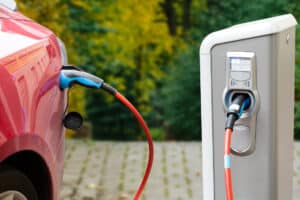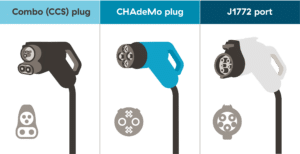Guide to stress-free EV charging – tips on how to plan ahead
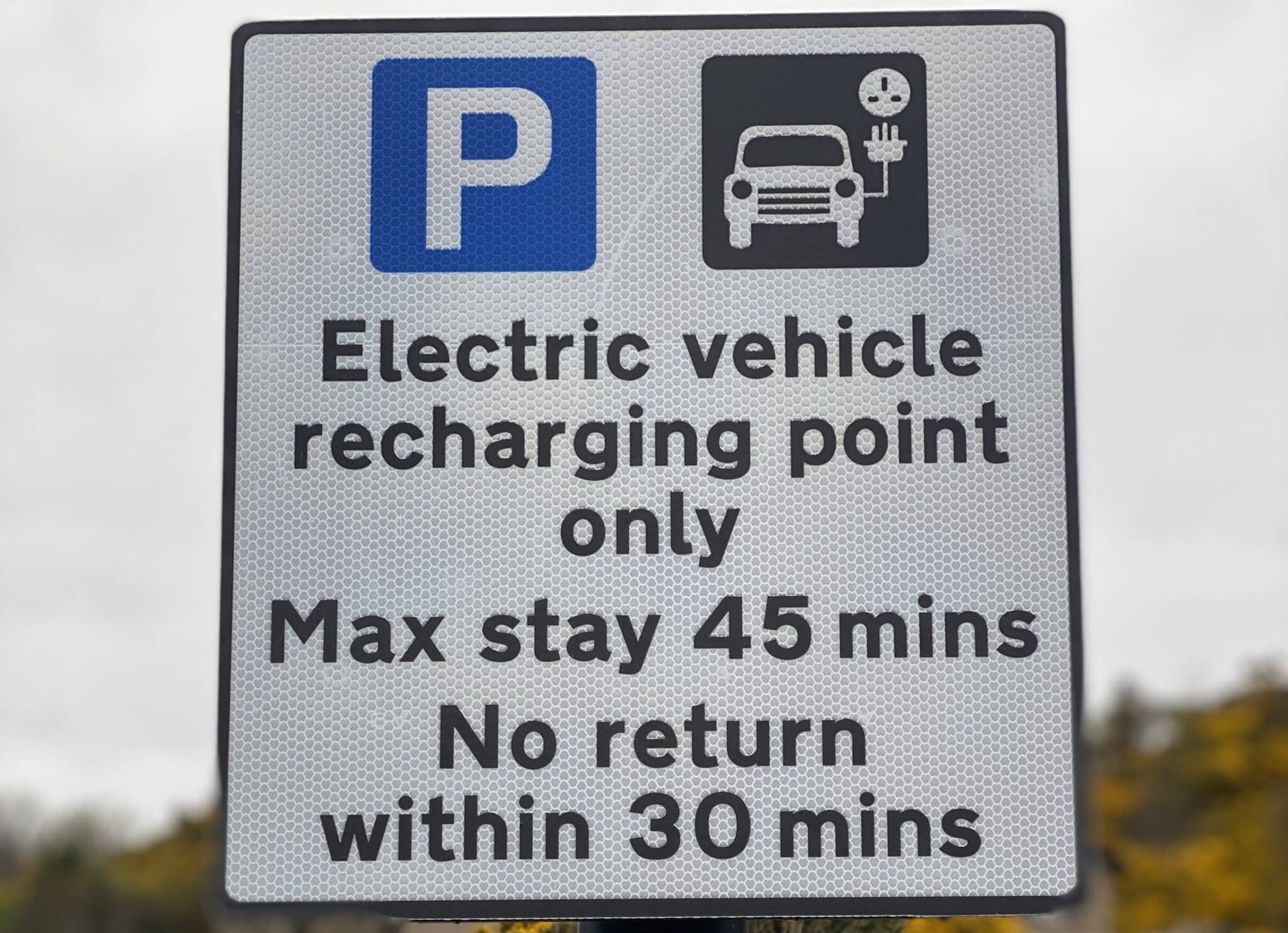
Switching to an electric vehicle (EV) requires a bit of a rethink on how we plan our journeys. Reassuringly, the main premise is the same – ‘don’t run out of fuel’. Ok, that’s not so reassuring, but knowing the enemy is half the battle. The other half is planning. Combating range anxiety, requires you to plan ahead, know your vehicle’s charging ability, know the route and crucially where you will charge and how much power each stop can deliver. We explore what to expect from an EV and how to have hours of stress-free, low-cost, zero-emission driving – provided you don’t run out of fuel – by planning your route well. There are some great tools to help you do that, some of them built-in to your car’s ‘toolbox’ or on your phone.
How EV Charging Works
Charging an EV involves plugging it into an electric power source, typically at charging stations strategically located across the country, or at home or work. Key is knowing how big your battery is, how fast it can charge (ie how much power it can draw down from the charger from different connections – there are a few!) and how much power each type of charger can deliver (and therefore how long it will take you to recharge).
Know your vehicle
It’s vital you know how big your car battery is (kWh) and how far it can travel (range), how economical it is (miles per kW) and last but definitely not least, how fast it can charge (kW again).
Battery size
Batteries are measured using kilowatt-hours (kWh), which shows how much power a battery can pump-out steadily for an hour before it runs out. Most cars are 50 or 75 kWh – which means the smaller, for example, can give out 50,000 watts (1 kilowatt equals 1000 watts of power) for a whole hour – which is equivalent to 25 kettles boiling for an hour before the battery runs out) – which is a lot of power.
Range
EV range depends on how big the battery is and how economically it drives. Range therefore varies from car-to-car, driver-to-driver and season-to-season. Car batteries don’t like to be too cold and give a poorer performance in cold weather. Knowing how far your car can travel before the battery runs out is possibly the most important thing to know. It is often the case that the range given by the manufacturer differs from the real-world range, so get to know what this is before taking it to the limits. The on-board computer will show how many miles you are getting from the power and will show pretty quickly (500 miles tends to do it) what your average economy is and what the range is after buying it.
Economy
The EV equivalent of miles per gallon (MPG) is miles per kilowatt (M/kW). Most family cars range from 2-3 M/kW. Again, after about 500 miles, your EV computer will have worked out your vehicle’s M/kW.
Factors that affect M/kW are speed you drive (the faster you drive the lower it gets) whether you have heating or aircon on (this can use up to 20% of the battery power), driving style (steady, non-aggressive driving with cruise-control on long journeys are most efficient) and driving conditions (warm, dry and not too hilly are best). Don’t forget, the better your M/kW, the longer your range and the cheaper the costs are to drive it.
Driving mode

Your EV will probably have two or three driving modes – Normal, Eco and Power (each manufacturer will have their own terms for these eg Sport mode).
Sport/Power mode
This mode will give you the best acceleration, using up more power in doing so, but also more fun (if you like that kind of thing).
Eco mode
This will deliver less power at acceleration and will make more use of regenerative breaking. This is when the brakes are replaced by an electric motor that puts the power of slowing down back into the battery. Heating and aircon tend also to be turned off. Most EVs will allow you to turn on the seat heating while in this mode. This uses much less power than the cab heating. While this is useful in the UK summer, it is uncomfortable in low temperatures or heatwaves.
Normal mode
This offers medium power and standard braking. You have full use of the heating and aircon.
Charging – types, speed and capacity
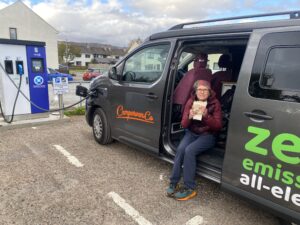
How fast your EV can charge depends on what type of charger you are connecting to – and what is available at the charging point. All of these together will determine when and where you need to charge, how long the charge will take and ultimately how long your trip will take.
Types of Charging:
Home Charging
This is the most convenient option and usually involves installing a home charging station. Most EVs come with a standard, three-pronged, household charger. These work well and can plug in almost anywhere, but they are very slow (usually 2-3kW max). For faster charging, consider a dedicated wall-mounted charger (up to 22kw if you have 3-phase electricity at home – most homes don’t, so 7kw will be the max).
Public Charging Stations
These are scattered throughout the UK, including motorway service areas, shopping centres, and public parking lots. These stations offer rapid chargers for quicker top-ups during journeys.
Public Charging Speeds
There are three categories, or levels, of chargers and two types of battery power output – AC/DC.
Charging types – AC or DC and why does it matter?
All batteries, such as those in a head-torch right up to those in your EV, use DC (Direct Current) power. EV chargers that offer DC power tend to be the quickest and most powerful ones as they ‘speak the same language’ as the EV battery. They don’t need adapters or invertors to get the power into the battery. Because of this, they are more efficient and often more powerful than AC chargers.
DC chargers are often the big ones you see at Tesla charge points or at service stations and have two or three thick attached (tethered) cables (see image below). The reason there are often three (one is usually blue) is because different cars have different connection types. CCS is the most common and will probably become the one we all use in the future (and bit like Beta and VHS video tapes in the 1980/90s).
Know your EV’s DC charge capacity
Despite chargers offering up to 350kW of DC power, most EVs can’t deal with that. Most DC chargers offer 50kW’s. This can charge a battery that is 20% full to 80% full in as little as 15-20 minutes – enough time for a toilet stop and a cuppa. On the whole EVs can take a 50-250kW charge, so check what capacity yours can take. For example our Eco Revolution is 100kW, most Teslas are 170 or 250kW while the Renault Zoe is only 50kW. Knowing this is important as it lets you know how long to expect the charges to take (see charge times explained below).
AC chargers are more common but slower
AC (Alternating Current) chargers are not as powerful as DC ones. AC is what we all have at home, so it is the most common type of electrical power and the type of charger you will get fitted at home. To charge your car battery from this source requires an in-built adapter – to change the current from AC in the wall to DC going into the battery. This is much like, say, a laptop charger that has a black box fixed to the middle of the cable, that changes 240 volt AC power to 19.5 volt DC power. The amount of power that is available to charge the car battery depends less on how much it can get from the wall socket (which can be a lot) and more on how much power the adapters can deal with.
Most cars are supplied with a power cable that has an adapter that looks like a beefed-up version of your laptop cable (Level 1). These are limited by the small box adapter’s power capacity and only give you around 2-3kw of power. Such chargers can take up to, and sometimes longer than, 48 hours to charge your car from scratch. That’s often fine when charging at home and you only do 50 miles or so a day.
Know your AC/DC power capacity
|
|
|
Most EVs also come with a second, slightly thicker, cable that has two big plugs on either end (about 60mm in diameter with five metal pins or pin holes in them – see above left). These can deliver up to 22kw of AC power directly to the vehicle and rely instead on the car’s onboard AC to DC adapter (Level 2) to charge the battery.
AC power capacity varies from car to car. For example, a standard Tesla Model’s adapter can only deal with 11kw of power whereas the small but resourceful Renault Zoe can deliver a mighty 22kw! These typically take 1-3 hours to charge your car from scratch. Note that even in the mighty Zoe, this is less than half of what it can take in the Rapid, Level 3, DC charger.
It is therefore important you know the capacity of your car on the DC and AC power options as this will determine charging times and ultimately how far you can travel in the timeframe you have.
Ask your dealer or check your manual for these important details before planning your journeys (spoiler alert – this is not often easy to find among the vehicle literature, so ask your dealer to save you a lot of search time).
Charging levels summary
Level 1 Charging (AC):
This is the slowest form of charging and typically involves a standard household socket. It is not commonly used for regular EV charging as it is too slow for most practical purposes.
Charging Power: Typically 2.4 to 3 kW.
Charging Time: 50kWh battery will take 30 hours to charge in a 2.4kw (10amp) charge.
Level 2 Charging (AC):
This type of charging is more common in public charging stations and home chargers. It provides higher power levels than Level 1.
Charging Power: Typically ranges from 3 kW to 22 kW.
Charging Time: Depending on the power level and the vehicle’s capacity, it may take 1-5 hours to charge.
DC Fast Charging (Level 3):
DC fast charging is the fastest form of public charging and is often found at dedicated charging stations along highways and in urban areas.
Charging Power: Typically ranges from 50 kW to 350 kW or more (check what your car can ultimately take – usually around 50-170 kw).
How long will a charge take?
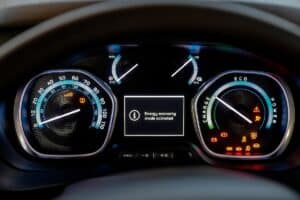
This requires a bit of maths. The time taken to charge depends on two things:
- Charge requirement: This is the size of your car battery and what it can take. This is defined in kilowatt hours (KWh), how empty or full is it and how full you want to charge it?
- Charge capacity: How much power is available from the charger and how much your car can handle (whichever is the lowest).
Now the maths bit: The time to charge equals the charge requirement divided by the charge capacity. This looks like this:

In non-maths speak, if you have a 50kWh Eco Revolution and you have a 7kW charger at home, this will take 7.14 hours to fully charge from empty. We get this by dividing the requirement – which is the full 50kW – by the charge capacity, which is 7kW. Hence: 50/7=7.14 hours or 7 hours and 8 minutes.
20-80% charge times
Most EV manufacturers like to talk about the time taken to go from 20-80% charge. This is conveniently quick and, in their defence, is often the charge scenario. The maths for this is a bit harder to work out but let’s try. Using our 50kW Eco Revolution again, a 20% charge means you have 10kWh’s left in the battery and you want to charge to 80% or to 40kWh’s. This means you are looking to get 30kW’s (40-10kW) from the charger. Doing the maths we divide the power required (30kW) by the power it can deliver (capacity) = 30/7=4.28 hours or 4 hours and 17 minutes.
While 4 hours is fine overnight or at work, it’s too long when charging en-route. This is why most drivers seek the faster 22kW charger or even better the 50kW DC chargers. This is also why there is often a queue for these faster chargers at service stations.
Times for a 50kW car with 11kW AC capacity is therefore 4.54 hours to full from empty (50/11=4.54) and 2.72 hours from 20-80% (30/11=2.72) – which is still too long for most.
On a 50kW DC charger a 50kWh car will fully charge in one hour (50/50=1). To charge from 20-80% will take 0.6 hours, or 36 minutes (30/50=0.6) – which is much more like it.
Below is a summary of charging times according to your car battery size and the charge capacity.
| Battery Size (kWh) |
Charge Capacity (kW) | Full Charge Time (hrs:minutes) | 20-80% Charge Time (hrs:minutes) |
| 50 | 7 | 07:08 | 03:34 |
| 50 | 11 | 04:33 | 02:16 |
| 50 | 22 | 02:16 | 01:08 |
| 50 | 50 | 01:00 | 00:30 |
| 50 | 100 | 00:30 | 00:15 |
| 50 | 170 | 00:17 | 00:08 |
| 50 | 250 | 00:12 | 00:06 |
| 50 | 350 | 00:08 | 00:04 |
| 75 | 7 | 10:43 | 05:22 |
| 75 | 11 | 06:49 | 03:25 |
| 75 | 22 | 03:25 | 01:43 |
| 75 | 50 | 01:30 | 00:45 |
| 75 | 100 | 01:45 | 00:23 |
| 75 | 170 | 00:26 | 00:13 |
| 75 | 250 | 00:18 | 00:09 |
| 75 | 350 | 00:13 | 00:06 |
Planning Your EV Journeys

Armed with the above information, you are almost ready to plan and take your stress-free electric journey. To do this, you will need to consider the available charging infrastructure, your vehicle’s capacity and range, and potential stops.
Long journeys usually involve motorways or highways. These in turn have service stations, many with EV charging stations. Checking these for type and capacity of chargers will help you plan. Also look out for local council chargers if you are travelling in Scotland. These are often in odd places like school car parks, next to recycling centres or Park&Ride areas. The ChargePlaceScotland app is good for these (see below).
That’s the good news. The bad news is that chargers are often busy, broken or not giving as much power as they should. This is, thankfully, getting better and we are seeing new charging points popping up in service stations, garage forecourts and in convenient locations – such as car parks, hotels and busy city streets. Be warned however, prices vary greatly, with highest prices at motorway service stations (see below on Costs).
To aid planning and work out the complicated sums, there’s quite a few EV planning apps that do this for you.
Planning Apps
There are a number of useful apps and websites that help drivers locate charging stations and plan routes, ensuring a smooth and stress-free journey. Many vehicles have their own planning apps. These are often the best option as they know your vehicle’s performance and range and can judge distances and when and where to charge very well. Unfortunately, some vehicle apps don’t have all of the available chargers listed, so having a back up plan or an alternative app is strongly recommended. Google Maps for example has a route planning facility and is fairly up to date on chargers.
- Route Planning Apps
- Utilize apps like Zap-Map, PlugShare, or A Better Routeplanner to find charging stations along your route.
- These apps often display real-time information on charger availability and charging speeds.
In Scotland use the excellent ChargePlaceScotland App. This gives live info on charger availability, price and capacity.
In almost all apps, enter your EV details such as capacity and M/kW and they will plan your route showing you where to stop for charging and when.
- Car charging companies and apps
Whereas the 1980s had three, maybe four video tape formats scrapping for market dominance, the EV charging world has over a dozen companies competing for your green pound – each with varying prices and reliability. Most accept credit and debit cards at the charge-point, while some, like Tesla chargers, require you to be registered with the company and use/own one of their vehicles. Here are the most commonly used ones:
Pod Point: Offers home and public charging solutions – often at large supermarkets such as Tesco
BP Chargemaster/Pulse: Provides charging infrastructure under the BP brand (was Polar).
Shell Recharge: Part of the Shell network, offering electric vehicle charging. Expect these on most petrol stations soon as they roll them out across UK/EU
Tesla Supercharger: Tesla’s proprietary network for charging Tesla vehicles. Fast and reliable. They are able to share some with non-Tesla vehicles, but not many.
Osprey Charging: Operates a network of rapid chargers. Prices tend to be high.
Ecotricity: Known for its Electric Highway charging network.
Ionity: A European network of high-power charging stations. Prices tend to be high
EV Power: MFG EV Power are competitive on price with an app that gets poor reviews
Instavolt: Present on lots of petrol station forecourts with reliable chargers and decent app
Gridserve: The usual presence at service stations. You can pay with debit/credit card at pump or become a member (best for business use) and use their app
GeniPoint: Often in good locations, though not numerous. Prices are not too bad.
How much does charging cost?

Prices depends on where you charge. The high street and motorway service stations are the most expensive, charging around 70p per kW. Charging at home on a special car or late-night tariff tends to be the cheapest option – starting at around 7p per kW. Most mid-priced options are around 40p per kW.
Our advice is speak to your electricity supplier and ask them for a cheap or smart tariff for your EV. If they don’t do one, then switch to one that does. Most, such as Octopus and OVO also fit chargers such as the 7kW AC option. These are great and combined with your smart tariff you can travel very cheaply everyday by plugging into the charger every time you are at home – letting the suppliers or car app choose the cheapest times to charge. You will need a smart meter fitted if you don’t have one already. If not, your supplier should be able to fit one for free.
Most people combine home with public charging, especially if you do many miles and long journeys. If you travel 350 miles a week, the average diesel car will cost around £63 a week. If you charge using the smart tariff at home, the same journeys will cost £4.82.
If you only have access to local mid-priced chargers this will cost £27.55.
Even at the pricey end, where you use service station chargers at 70p per kW, this is still only £48.22.
Don’t forget that service station petrol is more expensive too, so comparing like-for-like, if you fill up with service stations petrol, this will cost you around £83 for the week.
These are all calculated using £1.52/litre diesel in car with 38 mpg average versus and EV car giving 5.08 miles per kWh and charging rate of 7p per kW up to 70p per kW.
Vehicle Range and Charge Considerations
Charge regularly (at home or work)
If you use the car regularly always plug this in at home. For long trips, plan stops that are not near the low end of charge – especially if you have not used the charging point before (are they working, are they available, do you have the correct app?).
Use Apps
Zap-Map or even Google maps can work your route out for you by entering your car and battery size into the app then entering your start and end point. The app will then suggest stop off points, helping you plan your journey. If you are travelling 400 miles from London to Glasgow and have 150 miles range on your car, technically you need three stops, but you may need more. We recommend at least four, with you not going below 50 miles left on the tank. This way you can skip to the next service station if one is full or chargers not working and still have juice left.
Anticipate busy times
Don’t forget, when petrol stations are closed, almost all EV chargers are not (they are available 24-7). However, during peak times, they can be difficult to access. Weekday evenings can be busy when people return home from work and plug in their electric vehicles. Weekend afternoons, especially Saturday afternoons, might see increased demand as people engage in activities and may choose to charge their vehicles during leisure time.
Public Holidays and events that attract a higher number of people to a specific area can make them very busy. Charging points in a location, such popular beaches during warm dry weather might experience increased demand.
The morning peak often experiences higher demand as people charge before heading to work (though most try and do this the night before).Weekend early mornings and later evening times are often the quietest times (after 8pm)
Take the direct route
Many apps such as Google Maps and Waze tend to suggest routes that stick to highways and motorways, rather than more direct A roads. While these longer routes can be the quickest way for most vehicles (largely to do with being able to drive faster on highways), they may not be so for EVs. If you are looking for best economy, the more direct routes tend to use less energy, will suit slower, more economical travel (around 50-60 mph) and can link cheaper charging points (though not always). Crucially, a more direct and shorter route may make the difference between needing one charge stop and two – saving you not just energy and cost, but a lot of time. As always, a wee bit of planning, looking at different routes, may pay off, in more ways than one.
Charging Etiquette
Be mindful of others using charging stations; move your vehicle once charging is complete to allow others access. Plan for contingencies, such as unexpected detours or busy charging stations.
Running low
If you find yourself driving an electric vehicle (EV) that is low on power, also known as having low state of charge (SOC), here are some general tips to help you manage the situation:
Monitor Range and Plan Accordingly:
Keep a close eye on the estimated range provided by your EV’s dashboard. Plan your route to reach the nearest charging station or your destination without running out of power.
Reduce Speed:
Driving at lower speeds can help conserve energy and extend your remaining range. Avoid aggressive acceleration and high speeds, especially on highways.
Minimize Energy-Consuming Features:
Turn off unnecessary energy-consuming features such as air conditioning, heating, and other non-essential electrical systems to maximize your range.
Use Regenerative Braking:
If your EV is equipped with regenerative braking, use it to recapture energy when slowing down or descending hills. This can contribute to a small increase in your range.
Plan Charging Stops:
If you’re on a longer journey, plan stops at charging stations along the way. Many navigation systems in EVs can help you locate charging points and plan your route accordingly.
Activate Eco or Range Mode:
Some EVs have an eco or range mode that adjusts the vehicle’s performance to maximize efficiency. Consider activating this mode if available.
Emergency Reserves:
Most EVs have a small reserve of power even when the battery is nearly depleted. However, relying on this reserve is not a long-term solution, so it’s crucial to find a charging station as soon as possible.
Keep Emergency Equipment:
Carry a charging cable or adapter, if applicable, as well as emergency equipment like a flashlight, in case you need to charge from a standard power outlet in an emergency.
Stay Informed:
Use apps or in-car systems that provide real-time information about nearby charging stations and their availability. Some apps can also warn you if your estimated range is approaching your destination or a charging point.
Remember, it’s essential to plan your trips with charging infrastructure in mind, and keeping your EV adequately charged helps avoid running into low-power situations. Always refer to your vehicle’s manual for specific guidance and recommendations based on your EV model.
Government Support
The UK government provides grants to support the installation of home charging points. Incentives and grants for purchasing EVs are available to encourage widespread adoption. Below are some useful links:
UK – Electric vehicle chargepoint and infrastructure grant guidance for installers – GOV.UK (www.gov.uk)
Scotland – Domestic chargepoint funding – Energy Saving Trust
South Wales – OZEV Grant Approved Installer In Newport, Cardiff, Bridgend & More (southwalesev.co.uk)
Conclusion
Embracing electric vehicles in the UK is not only a step towards a sustainable future but also a convenient and rewarding driving experience. With a robust charging infrastructure, user-friendly apps, and government support, EV drivers can confidently plan journeys, reduce range anxiety, and contribute to a cleaner environment. As technology continues to advance, the electric highway is becoming more accessible, encouraging more drivers to make the switch to electric vehicles. Driving an EV is cleaner, much cleaner, than petrol or diesel, has lower car tax, is cheaper to drive in cities and can cost much less to run. Doing so without worrying about running out of power is no different to driving a diesel or petrol car, it is just a bit different. Think ahead and charge regularly.

